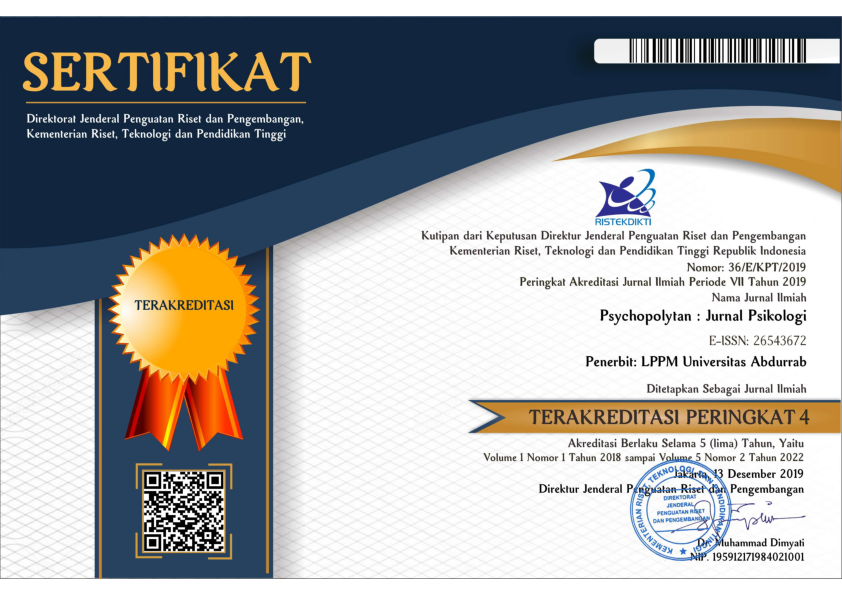Fungsi Eksekutif pada Prasangka Pengguna Facebook terhadap Presiden RI
Abstract
Penelitian ini bertujuan untuk mengetahui hubungan antara fungsi eksekutif terhadap prasangka pada pengguna facebook. Subjek penelitian ini berjumlah 125 subjek yang berusia 20 – 40 tahun di kota Pekanbaru (78 wanita; 47 laki-laki). Teknik pemilihan sampel menggunakan accidental sampling. Data dikumpulkan dengan menggunakan dua skala, yaitu skala fungsi eksekutif dan skala prasangka. Skala disebarkan secara online menggunakan google form. Analisis dalam penelitian ini menggunakan pearson product moment. Hasil analisis menunjukkan adanya hubungan negative antara fungsi eksekutif terhadap prasangka (p<0,05). Koefisien korelasi antara fungsi eksekutif dan prasangka adalah -0,301. Temuan ini menunjukkan semakin tinggi fungsi eksekutif maka semakin rendah prasangka, atau sebaliknya semakin rendah fungsi eksekutif maka semakin besar kemungkinan individu untuk berprasangka kepada presiden RI.
References
Ali, K. A., & Zinna, A. A. (2018). Relationship between Prejudice , Social Media Addiction , Empathy and Trust. The International Journal of Indian Psychology, 6(3). https://doi.org/10.25215/0603.034
Anderson, V., Jacobs, R., & Anderson, P. J. (2011). Executive functions and the frontal lobes: A lifespan perspective. Executive Functions and the Frontal Lobes: A Lifespan Perspective. https://doi.org/10.4324/9780203837863
APJII [Asosiasi Penyedia Jasa Internet Indonesia]. (2018a). Laporan Survei : Penetrasi & Profil Perilaku Pengguna Internet Indonesia. APJII. Retrieved from www.apjii.or.id
APJII [Asosiasi Penyedia Jasa Internet Indonesia]. (2018b). Survei APJII: Penetrasi Internet di Indonesia Capai 143 Juta Jiwa. Buletin APJII, Edisi-22(Maret), 1–7.
APJII [Asosiasi Penyedia Jasa Internet Indonesia]. (2019). Laporan Survei : Penetrasi & Profil Perilaku Pengguna Interneet Indonesia. Buletin APJII, Edisi 40(Mei), 1–6. Retrieved from https://apjii.or.id/survei
Baker, N. L. (2002). Prejudice. In J. Worell (Ed.), Encyclopedia of women and gender (pp. 865–877). USA: Academic Press.
Bissell, K., & Parrott, S. (2013). Prejudice: the role of the media in the development of social bias. Journalism and Communication Monographs, 15(4), 219–270. https://doi.org/10.1177/1522637913504401
Dawson, P., & Guare, R. (2006). Executive Skills in Children and Adolescents. Journal of Developmental & Behavioral Pediatrics (2nd ed.). The Guilford Press. https://doi.org/10.1097/00004703-200606000-00014
Duckitt, J. (1992). Prejudice and behavior: A review. Current Psychology : Research & Reviews, 11(4), 291–307. https://doi.org/10.1007/BF02686787
Geldhof, G. J., Little, T. D., & Colombo, J. (2010). Self-regulation across the life span. In R. M. Lerner, M. E. Lamb, & A. M. Freund (Eds.), The handbook of life-span development: Social and emotional development (pp. 116–157). USA: John Wiley & Sons.
Hootsuite (we are social). (2019). Indonesia Digital Report 2019.
Ito, T. A., Friedman, N. P., Bartholow, B. D., Correll, J., Loersch, C., Altamirano, L. J., & Miyake, A. (2017). Toward a Comprehensive Understanding of Executive Cognitive Function in Implicit Racial Bias. Journal of Personality and Social Psychology, 18(2), 187–218. https://doi.org/10.1016/j.physbeh.2017.03.040
JR, B. E. W., & Kite, M. E. (2016). The Psychology of Prejudice and Discrimination (Second Thi). New York: Taylor & Francis.
Kennedy, M. R. T. (2017). Coaching college students with executive function problems. The Guilford Press. New York: The Guilford Press.
Krämer, U. M., Kopyciok, R. P. J., Richter, S., Rodriguez-Fornells, A., & Münte, T. F. (2011). The role of executive functions in the control of aggressive behavior. Frontiers in Psychology, 2(JUL), 1–10. https://doi.org/10.3389/fpsyg.2011.00152
Krendl, A. C., Heatherton, T. F., & Kensinger, E. A. (2009). Aging Minds and Twisting Attitudes: An fMRI Investigation of Age Differences in Inhibiting Prejudice. Psychology and Aging, 24(3), 530–541. https://doi.org/10.1037/a0016065
Lindsay, P. H., & Donald A Norman. (1997). Human Information Processing : An Introduction to Psychology (Second Edi). New York: Academic Press.
Payne, B. K. (2005). Conceptualizing Control in Social Cognition: How Executive Functioning Modulates the Expression of Automatic Stereotyping. Journal of Personality and Social Psychology, 89(4), 488 –503. https://doi.org/10.1037/0022-3514.89.4.488
Sampson, E. E. (1999). Dealing with Differences: An Introduction to the Social Psychology of Prejudice. New York: Harcourt Brace.
Stewart, B. D., von Hippel, W., & Radvansky, G. A. (2009). Age, Race, and Implicit Prejudice. Psychological Science. https://doi.org/10.1111/j.1467-9280.2009.02274.x
Walgito, B. (2003). Psikologi Sosial. Yogyakarta: Penerbit ANDY.
1. Copyright of all journal manuscripts is held by the Psychopolytan : Jurnal Psikologi
2. Formal legal provisions to access digital articles of electronic journal are subject to the provision of the Creative Commons Attribution-ShareAlike license (CC BY-NC-SA), which means that Psychopolytan : Jurnal Psikologi is rightful to keep, transfer media/format, manage in the form of databases, maintain, and publish articles.
3. Published manuscripts both printed and electronic are open access for educational, research, and library purposes. Additionally, the editorial board is not responsible for any violations of copyright law.
licensed under a Creative Commons Attribution-ShareAlike 4.0 International License.
 pdf
pdf
 Abstract views: 348
Abstract views: 348
 downloads: 378
downloads: 378

 :
:








